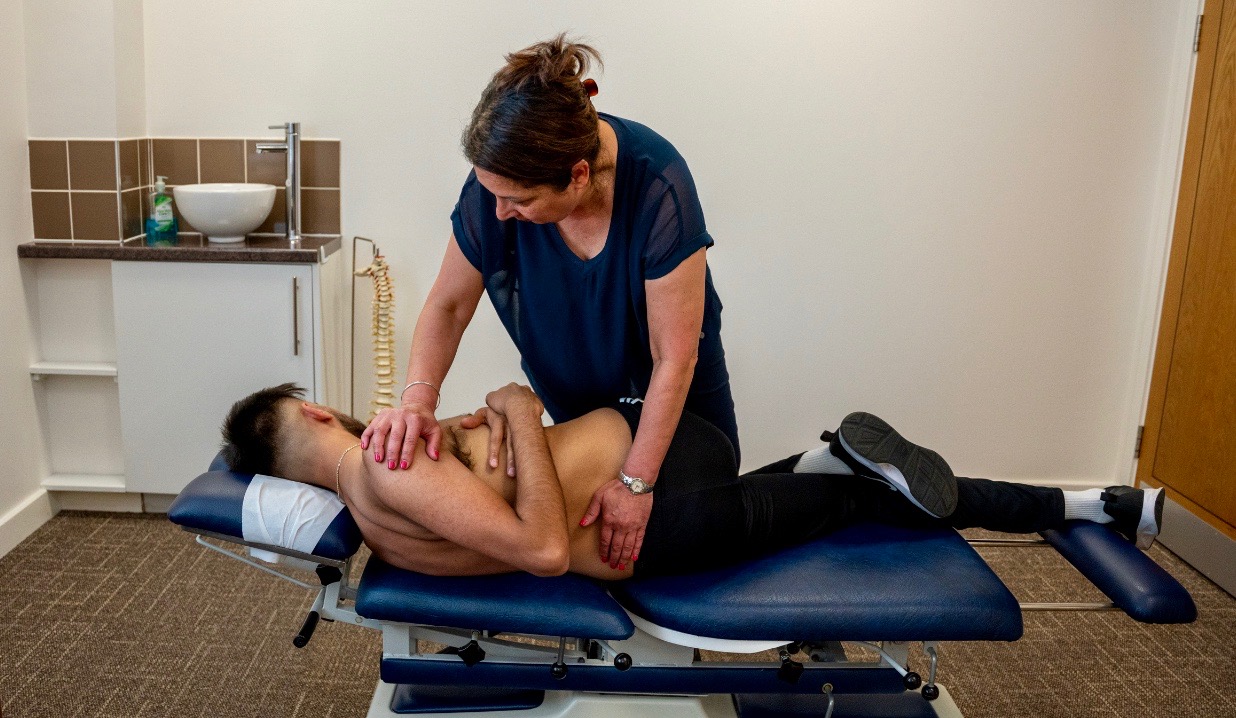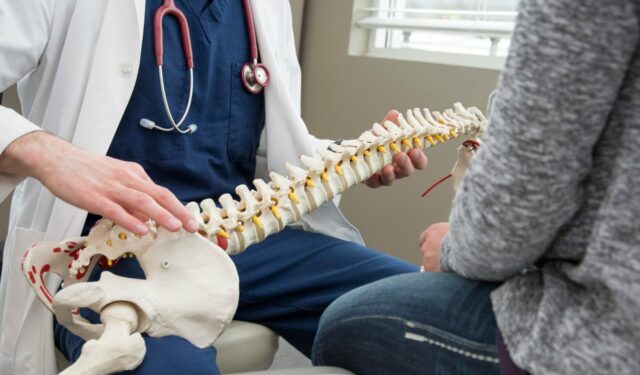
Chiropractic Awareness Month
What is chiropractic?
Facet Joint Pain – What It Is and How We Can Help
Chiropractic care is a helpful and effective way to treat facet joint syndrome, sometimes called facet sprain or simply facet pain. It is one of the more common causes of back pain that we see and treat regularly in our clinics.
Facet joints, also known as zygapophyseal joints, are found at the back of the spine. Each level of your spine has two of them – one on each side. These joints are a bit like other joints in your body, such as the ankle. They are synovial joints, which means they are surrounded by a joint capsule, contain fluid, and are lined with smooth cartilage to help them move easily.
The job of the facet joints is to guide and limit movement in the spine, especially when you twist or lean backwards. They also help keep your spine stable.
Injuries to the facet joints usually happen when there is too much movement in one direction, which can stretch or tear the joint capsule. This causes swelling, inflammation and pain. When this happens, your body often reacts with muscle spasms to protect the area, but that can make the pain feel even worse and limit your movement. The pain can come on suddenly and be quite intense, similar to what you might feel with a sprained ankle.
In most cases, the pain is worst during the first few days and then slowly improves. The tricky part is that while you can rest an ankle easily, it is much harder to avoid using your back, which makes healing a bit more challenging.
Many patients tell us they had a small “twinge” in their back before the stronger pain started. This often means there was already a minor injury in the joint that later flared up. If the sprain is more serious, recovery can take a bit longer. It usually takes anywhere from two to six weeks for the joint capsule or ligament to fully heal.
At Isis Chiropractic Centres, we are here to support your recovery every step of the way and help you get back to moving with ease and confidence.

Want to know more? Request a Callback
Or give us a call, to find out how we can help you with Facet Joint Syndrome and Chiropractic Treatment.
Book an Appointment
Schedule an appointment for Facet Joint Syndrome and Chiropractic Treatment tailored to your needs.
Think of your spine as a long chain made up of many small joints, all supported by muscles and ligaments. When some of those joints become stiff, maybe due to old injuries, wear and tear, or changes in your anatomy, other joints have to work harder to keep you moving. Over time, that extra strain on the more flexible joints can lead to pain from overuse or sprain.
Most of the time, this happens slowly through what we call repeated micro-trauma. That means lots of tiny stresses build up over time until something finally gives, often during a very simple everyday movement. Many people hurt their backs doing something as minor as picking up a pen or twisting slightly in the wrong way. It may not be heavy lifting or anything unusual. Often, it is just a movement you have done a hundred times before.
There is also another way facet joint pain can start, and it involves something called meniscoid entrapment. Inside the joint capsule, there can be a small fold of tissue that sometimes slips between the joint surfaces and gets trapped. When that happens, it can cause sudden and intense pain.
In cases like this, chiropractic treatment can make a big difference — sometimes even bringing instant relief with just one session of spinal manipulation. It may feel like a small miracle, but it is really just the result of freeing the trapped tissue and allowing the joint to move comfortably again.
At Isis Chiropractic Centres, we are here to help you understand what is going on with your back and find the right treatment to get you feeling better, faster.
Typically, there is pain just to one side of the spine. The pain is usually felt to the side and lower than the actual site of the injury and the referred pain from the lower spine is sometimes felt in the buttock, groin or down the thigh.
Referred pain from the facet joints in the neck is usually felt over the neck, shoulder and arm, and the referred pain from the mid back is usually felt along the ribs giving rise to rib pain.
Even tough rest and inactivity helps to alleviate the pain, the back will generally feel stiff in the morning and after inactivity. Sometimes inactivity aggravates the muscle pain and therefore, it is best to alternate rest with moving and walking around.
In rare cases there may be irritation of the nerve roots, giving neurological symptoms such as a feeling of numbness and pins and needles. If neurological symptoms are present it is termed lateral dynamic stenosis. Other possible causes for nerve entrapments include disc herniations. Go to chiropractic treatment and disc herniations.
A chiropractor is usually able to make a diagnosis based on the history and the signs and symptoms of the condition.
Sometimes, especially if the problem is long standing, if you have reached a certain age or if there is anything in your medical history to indicate it we may take an x-ray of the spine.
You cannot diagnose a facet joint sprain on an x-ray, or CT or MRI-scan alone. The diagnosis is made on the clinical findings – but the x-ray may help to rule out other causes and in some cases help the chiropractor determine which type of chiropractic treatment is most appropriate.
If you suspect that you have sustained a facet joint sprain, rest and use an ice pack. The initial treatment involves avoiding the movements that cause the joints to be painful, but prolonged rest is not advisable.
Make an appointment with your chiropractor as soon as possible to have the problem properly diagnosed. Once the diagnosis is made the appropriate treatment can be given.
Chiropractic treatment would normally involve early manipulation to release the muscle spasm. The manipulation is not done the injured joint and the most appropriate treatment method will be chosen to avoid aggravating the problem, so don’t expect the treatment to be painful.
The chiropractor will also give advice on how to get comfortable, how to move, and taught which exercises to do to get comfortable and help you to get on with your life as comfortably as possible.
In our clinics we often hear from patients that they find painkillers ineffective. Some people advocate the use of non-steroidal anti-inflammatory (NSAIDs) drugs, which is an option if your pain is severe but you need to be aware of the possible side-effects.
In an acute (short term) injury normally the pain subsides within 4-6 treatments. Once the pain has subsided core muscle exercises will gradually be introduced to create better spinal control and stability, which is one way of preventing the injury from coming back.
You will also be giving postural and ergonomic advice to help you reducing the risk of injury.
In a more chronic (long standing) type of facet joint problem, the management is more involved.
Often degenerative changes may be present in the joints and discs. Degeneration of the discs will lead to reduction of the height of the disc, which in turn increase the weight bearing demand on the facet joints and that makes the joint more vulnerable to injury.
The main difference in the treatment is that the period and number of sessions may have to be extended.
Also, doing exercise long term will be extremely important to create more support and stability for the spine. In some cases ‘curing’ the problem might not be possible, but the goal of the treatment will be to make sure the problem stays manageable, allowing you to do your normal daily activities.
National guidelines for treatment of back pain have advised against long term use of non-steroidal anti-inflammatory (NSAIDs) drugs, facet joint injections, nerve denervations and surgery.
If you suffer recurrent episodes of facet joint pain it is usually a sign of what chiropractors would refer to as a ‘functional instability’. When you get a joint or ligament sprain the healing create scar tissue as part of the normal healing process.
Scar tissue is less elastic and breaks more easily. It has also been shown that injuries leave the deeper spinal muscles weakened, permanently, even after the pain has gone. The only way to make the muscle recover is to do specific core muscle exercises.
There are many different treatments available. Recent research shows that chiropractic treatment, spinal manipulation of the type chiropractors do, in combination with exercises is the most effective treatment for both acute and chronic facet joint pain.
Chiropractors advocate dealing with the underlying neurological, mechanical and muscular problems. Just relying on taking pain killers and rest does not deal with neither of these causes, so even if the pain goes away with rest it is bound to come back due to the remaining underlying weakness.
For each new episode of pain you have you become more at risk to have another episode. Research show that after four episodes of pain you are more likely to suffer chronic and long-term pain.
These are all risk factors for developing back pain:
So, the longer you have put up with the pain the more likely you are to become a chronic and recurrent sufferer.
The general recommendation is to make sure you get the problem diagnosed properly, have a chiropractor evaluating your core stability, have treatment if necessary and do the right type of exercise to help your problem.